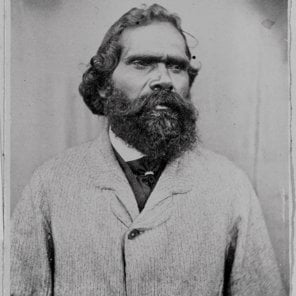
- Inducted:
- 2014
Simon Wonga was an important Aboriginal leader, who became ngurungaeta, or 'head man', of the Wurundjeri people in the mid-19th century, at a time when their future was uncertain. He helped his people face the loss of their traditional way of life, and achieved his vision for an Aboriginal settlement at Coranderrk.
His traditional upbringing was disrupted by the arrival of European settlers
Born around Healesville in 1821, Simon was the son of Billibellari, another highly respected ngurungaeta. The qualities he displayed as a child saw him identified early on as a future leader, however his traditional upbringing was disrupted by the arrival of European settlers in 1835, shortly after his initiation ceremony. Simon was 13 years old when his father and 7 other Wurundjeri Elders met with John Batman. At this meeting, he and his cousin, William Barak, another future Wurundjeri leader, witnessed the signing of a historically contentious 'treaty' by the Elders and Batman, which heralded the establishment of a permanent British colony in Victoria.
When he was 19 years old, Simon seriously injured his foot while hunting in the Dandenong Ranges. He was taken to the home of William Thomas, the Assistant Aboriginal Protector appointed by the British Colonial Office to oversee the care of the region's diminishing population of Aboriginal people. It took 2 months for Simon's foot to recover, during which time he stayed with Thomas and gained useful insights into non-Aboriginal society. It was Thomas who noted 2 of Simon's unique gifts – his talent for mimicking animal calls and his ability to communicate with horses.
Simon officially became ngurungaeta
After his father's death in 1846, 25-year-old Simon was chosen to be the next ngurungaeta. He did not take over the leadership immediately, but instead worked in jobs that would teach him about colonial life. One employer was so impressed by Simon's skill at mustering cattle that he renamed his station Wonga Park – today a locality within greater Melbourne. Simon also negotiated contracts with settlers to cut timber, employing other Aboriginal men to assist him. He did not allow himself to be exploited, as one publican learned when his attempt to short-change Simon resulted in the threat of legal action from William Thomas, to whom Simon had complained.
In 1851, Simon officially became ngurungaeta. By this time, he understood that his country had been permanently altered by European colonisation, and that Aboriginal people would have to adapt to survive. In recognition of what this meant giving up, he organised 2 significant events. The first was the last Wurundjeri initiation ceremony, held at Hanging Rock. In an unprecedented gesture of reconciliation, Simon invited two English boys, Willie and Tom Chivers – who along with their father John were among the only settlers to learn the Woi wurrung language of the Wurundjeri people – to accompany the party. In 1852, Simon also brought together the people of the Kulin and other nations for one final corroboree at Pound Bend in Warrandyte. It was a huge 2 week celebration of traditional culture, including music, ceremony and traditional games such as marngrook, a version of football, which attracted many curious non-Aboriginal spectators.
Mohican Station
In Simon's view, Aboriginal people had no future without access to land of their own. He believed they could live self-sufficiently alongside the settlers if allowed to farm. For the next decade, Simon fought to bring his plan to fruition, ably assisted by William Barak. It was not easy. Influential local squatters opposed Simon's preferred site for a settlement by the Acheron River. Instead, Mohican Station was established north west of Cathedral Mountain. It was cold, unsuitable for agriculture, and unpopular with the Aboriginal people who were relocated there. Despite the setbacks, Simon found an ally in John Green, a reverend appointed to supervise Mohican Station, who became a key supporter of his cause.
Coranderrk
In early 1863, Mohican Station was abandoned. Simon and William Barak led around thirty Kulin people through the Dandenong Ranges, following a traditional songlines route known today as the famous Black Spur road. They settled at a traditional camping spot on Badger Creek near Healesville. In a politically savvy move, Simon formed a deputation to travel to Melbourne and appeal to the Governor of Victoria, Henry Barkly, for ownership of the chosen site. The group came bearing gifts, including hand-woven baskets and traditional weapons and Simon delivered a heartfelt address in Woi wurrung. As a result, Governor Barkly successfully pressured the government to gazette 2300 acres for use as a reserve in June 1863.
The new reserve was named Coranderrk, after a flowering plant, and John Green was appointed manager. By 1865, Coranderrk's population had grown to 105 people, making it Victoria's largest Aboriginal reserve at the time. Within four years, the residents had cleared a large area of land and built a thriving farming community, complete with a bakery, butcher and school. Coranderrk at the time was the most economically successful Aboriginal mission station in Australia. John Green also ensured it was one of the most autonomous, and Simon contributed to its management until he passed away in 1874.
While it fell to William Barak to save Coranderrk from closure in the following years, that it existed at all was due to Simon Wonga and his unflagging determination. Without him, his people may never have regained a place for themselves in the country that was taken from them.
Updated

